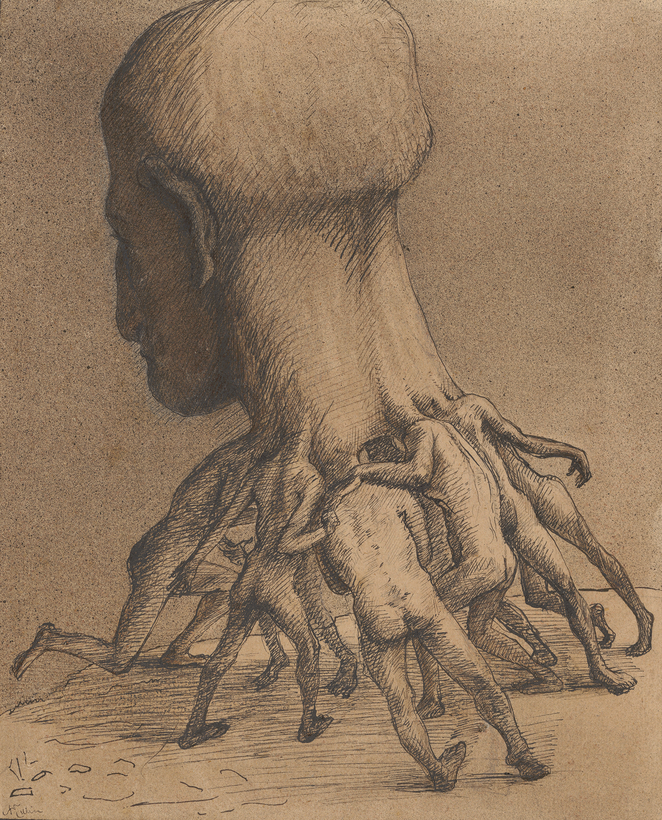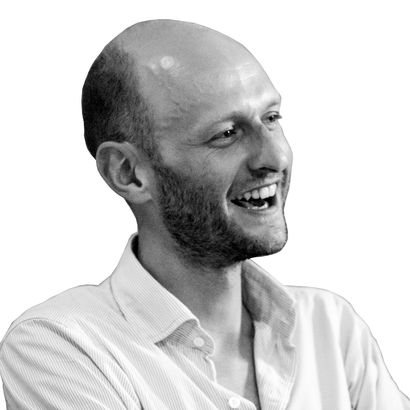One morning, around the year 1900, the Austrian artist Alfred Kubin sat down at his desk in Munich and pondered what to draw that day. Picking up his pen and a small piece of paper roughly five by seven inches, he sketched the figure of a naked, emaciated man, his hands tied behind his back. The man is suspended horizontally like a hammock, with his feet tied to the top of a pole while his head is held aloft by a stake through his mouth. A fire burns beneath him, scorching his belly black. Satisfied, Kubin titled the picture Torture.
Torture is one of the thousands of nightmarish visions that Kubin drew across his long career. Beginning on August 14, at Vienna’s Albertina Modern museum, the exhibition “Alfred Kubin: The Aesthetics of Evil” invites the public to consider what drove the artist to such dark, even disgusting, corners of his imagination.

Born in Bohemia in 1877, Kubin was 10 when he witnessed his mother’s painful death from tuberculosis. Four months later, his father, an authoritarian figure who regularly beat him, married the sister of his deceased wife. She then died following childbirth. Still young, Kubin was sexually abused by a pregnant woman. Is it surprising that by his late teens he was an alcoholic and a nervous wreck? After a failed suicide attempt on his mother’s grave, he enlisted in the army, only to break down 18 days later when a comrade’s sudden death sent him into a delusion—he thought he was a Bourbon prince. The subsequent three months in hospital allowed him to observe “all the miserable sick and dying and the suicides.”
While it’s tempting to think of Kubin’s work as having sprung straight from the head of a madman, art history tells a slightly different story. Kubin’s motifs—serpents, skulls, spiders, and naked women—are deeply rooted in the iconography of evil, from Roman sculptures and medieval manuscripts to Michelangelo’s Last Judgment and Goya’s Black Paintings. They also populated the work of his anxious fin-de-siècle artist allies: Gustav Klimt, Egon Schiele, Edvard Munch, James Ensor, Odilon Redon, and Max Klinger.

Elizabeth Dutz, the show’s curator, thinks Kubin’s output comes from a combination of factors. “He had such a traumatic youth, and his life was very problematic, which made him very sensitive. So he built himself this imaginary world of nature and fairy tales and monsters.”
For this exhibition, Dutz was tasked with selecting approximately 100 illustrations from the 1,800 in the Albertina’s stores. “The exhibition concentrates on his early works made up until 1904, more or less. These are his intense, nightmarish works, covering topics like alienation, beasts, monstrosities, ruin, and death.” Some 20 years later, the same fascination with these topics would become a defining characteristic of the Surrealist movement.

Kubin may seem the archetypal tortured artist, but Dutz points out that he did find fame and fortune. After mingling in Expressionist circles, he won important patrons, gained several major European dealers, and mounted dozens of prestigious exhibitions—including a show at the 1952 Venice Biennale. Following his death, in 1959, Austria hailed him as a national hero. And what about his reputation today? “He is very well known here,” Dutz replies. “He comes immediately after Klimt, Schiele, and Kokoschka.”
“Alfred Kubin: The Aesthetics of Evil” will be on at the Albertina Modern, in Vienna, from August 14, 2024, to January 6, 2025
Harry Seymour is a London-based art historian and writer


